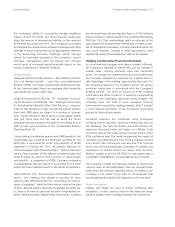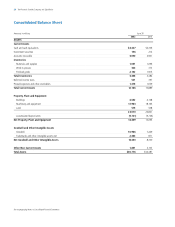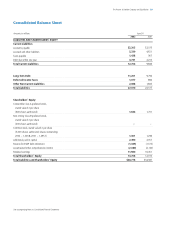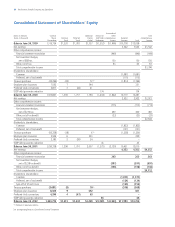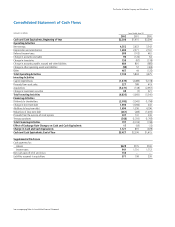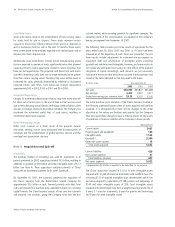Proctor and Gamble 2002 Annual Report Download - page 34
Download and view the complete annual report
Please find page 34 of the 2002 Proctor and Gamble annual report below. You can navigate through the pages in the report by either clicking on the pages listed below, or by using the keyword search tool below to find specific information within the annual report.32 The Procter & Gamble Company and Subsidiaries
Millions of dollars except per share amounts
Note 1 Summary of Significant Accounting Policies
Basis of Presentation: The consolidated financial statements include The
Procter & Gamble Company and its controlled subsidiaries (the Compa-
ny). Intercompany transactions are eliminated in consolidation. Invest-
ments in companies over which the Company exerts significant
influence, but does not control the financial and operating decisions, are
accounted for using the equity method. These investments are managed
as integral parts of the Company’s business units, and segment report-
ing reflects such investments as consolidated subsidiaries with applica-
ble adjustments to comply with U.S. GAAP in the corporate segment.
Use of Estimates: Preparation of financial statements in conformity with
accounting principles generally accepted in the United States of
America requires management to make estimates and assumptions that
affect the amounts reported in the consolidated financial statements
and accompanying disclosures. These estimates are based on manage-
ment’s best knowledge of current events and actions the Company may
undertake in the future. Actual results may ultimately differ from
estimates, although management does not believe such changes will
materially affect the financial statements in any individual year.
New Pronouncements: On July 1, 2001, the Company adopted
Statement of Financial Accounting Standards (SFAS) No. 141, “Business
Combinations,” and SFAS No. 142, “Goodwill and Other Intangible
Assets.”
SFAS No. 141 applies to all business combinations with a closing date
after June 30, 2001. This Statement eliminates the pooling-of-interests
method of accounting and further clarifies the criteria for recognition of
intangible assets separately from goodwill.
SFAS No. 142 eliminates the amortization of goodwill and
indefinite-lived intangible assets and initiates an annual review for
impairment. Identifiable intangible assets with determinable useful lives
will continue to be amortized. Beginning July 1, 2001, the Company
ceased amortizing goodwill and indefinite-lived intangible assets. At
that time, management performed an impairment test of existing
goodwill and concluded there was no goodwill impairment.
In June 2001, the FASB issued SFAS No. 143, “Accounting for Asset
Retirement Obligations,” which addresses the financial accounting and
reporting for obligations associated with the retirement of tangible
long-lived assets and the associated asset retirement costs. In August
2001, the FASB issued SFAS No. 144, “Accounting for the Impairment
or Disposal of Long-Lived Assets,” which addresses the financial
accounting and reporting for the impairment or disposal of long-lived
assets. The Company will adopt both SFAS No. 143 and SFAS No.144
on July 1, 2002, and does not expect these Statements to materially
impact the Company’s financial statements.
In June 2002, the FASB issued SFAS No. 146, “Accounting for Costs
Associated with Exit or Disposal Activities.” This pronouncement is
effective for exit or disposal activities that are initiated after December
31, 2002, and requires these costs to be recognized when the liability
is incurred and not at project initiation. The Company is reviewing the
provisions of this Statement, but does not expect it to have a material
impact on the Company‘s financial statements.
Revenue Recognition: Sales are recognized when revenue is realized or
realizable and has been earned. Most revenue transactions represent
sales of inventory. In general, revenue is recognized when risk and title
to the product transfers to the customer. A provision for discounts and
other allowances is taken as a reduction in sales within the same period
the revenue is recognized.
Currency Translation: Financial statements of subsidiaries outside the
U.S. generally are measured using the local currency as the functional
currency. Adjustments to translate those statements into U.S. dollars at
the balance sheet date are recorded in other comprehensive income. For
subsidiaries operating in highly inflationary economies, the U.S. dollar is
the functional currency. Remeasurement adjustments for highly infla-
tionary economies and other transactional exchange gains and losses
are reflected in earnings.
Cash Equivalents: Highly liquid investments with maturities of three
months or less when purchased are considered cash equivalents and
recorded at cost, which approximates fair value.
Investment Securities: Investment securities consist of short-term readily
marketable instruments that mature within one year. These securities
are reported at fair value and classified as available for sale, with
unrealized gains or losses recorded net of tax in other comprehensive
income.
Inventory Valuation: Inventories are valued at cost, which is not in
excess of current market prices. Cost is primarily determined by either
the average cost or the first-in, first-out method, with minor amounts
maintained on the last-in, first-out method. The replacement cost of
last-in, first-out inventories exceeded carrying value by approximately
$27 and $55 at June 30, 2002 and 2001, respectively.
Goodwill and Other Intangible Assets: The cost of intangible assets with
determinable useful lives is amortized to reflect the pattern of economic
benefits consumed, principally on a straight-line basis, over the
estimated periods benefited, ranging from 5 to 40 years. Goodwill and
Notes to Consolidated Financial Statements



